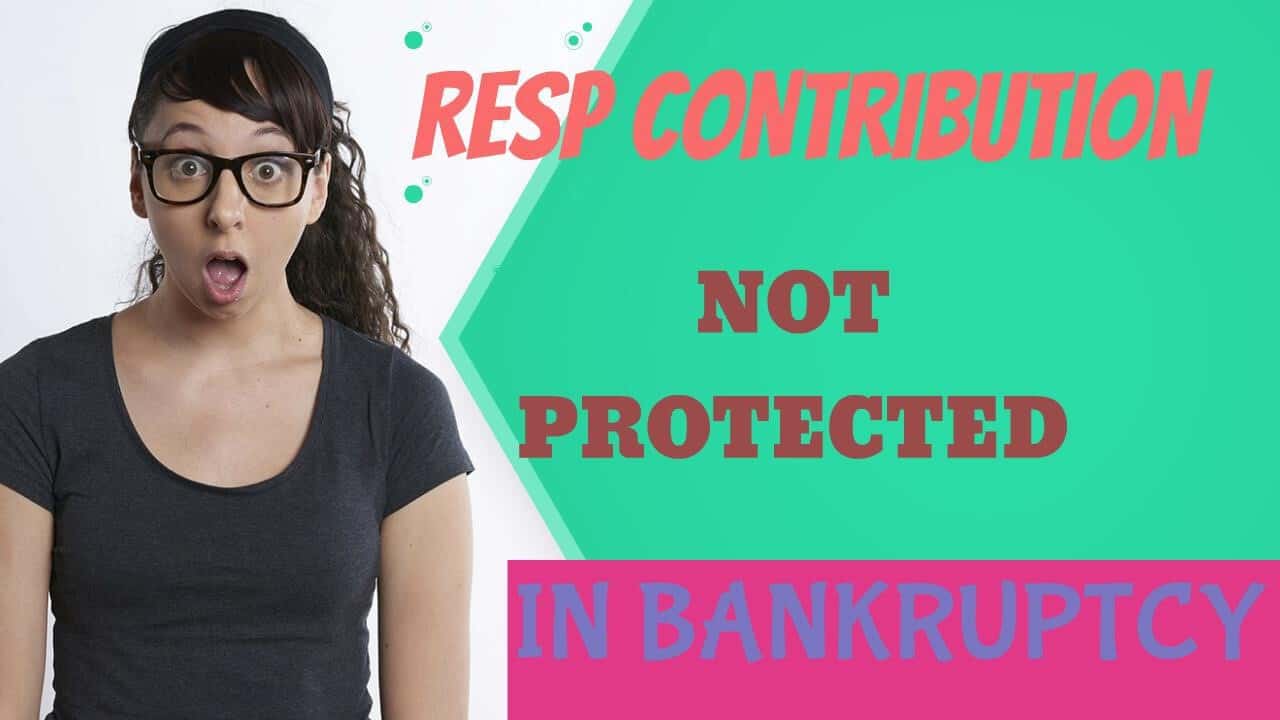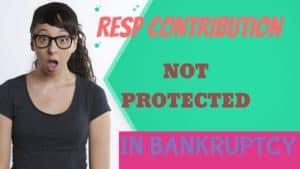
If you would prefer to listen to the audio version of this RESP contribution not protected in bankruptcy Brandon’s Blog, please scroll down to the bottom and click on the podcast
Thank you for reading our Brandon's Blog. Check out our AI insolvency bot on this page and don't forget to subscribe!
Introduction
Many parents contribute to a Registered Education Savings Plan (RESP) to save for their children’s post-secondary education. Unlike a Registered Retirement Savings Plan (RRSP), an RESP contribution, or the total of all contributions made by the parent(s), is subject to seizure in the bankruptcy of the owner of the RESP.
In Brandon’s Blog, I discuss the history of why an RRSP is largely exempt from seizure in a bankruptcy, while a Registered Disability Savings Plan (RDSP) and an RESP are not. The rules governing whether an RRSP or Registered Retirement Income Fund (RRIF), RDSP or RESP are exempt from seizure or not is an interplay between both federal and provincial laws. As I practise in the province of Ontario, I will speak only about the Ontario situation.

RRSP or RRIF exemption
Before 2008, whether an RRSP was exempt from seizure or not relied solely upon provincial law. There was no federal law which outlined the treatment for an RRSP in bankruptcy. Effective July 2008, the assets contained in either an RRSP or a RRIF were codified in the Bankruptcy and Insolvency Act (Canada) (BIA) to be exempt from seizure, except for contributions made to an RRSP in the 12 months prior to the date of bankruptcy.
The only exception would be based on whether or not RRSPs and RRIFs were exempt from seizure under provincial law. So, in the case of Ontario, the 12-month clawback exists. The bankrupt has to pay the equivalent of the contributions made in the 12 months before the date of bankruptcy.
The reason for making this change to the BIA was because there was an inequality amongst RRSPs. If you held your RRSP at a financial institution, then it was not exempt from seizure in a bankruptcy. However, if you held your RRSP:
- with an insurance company; AND
- you had made an irrevocable designation that in the event of your death, the beneficiary of your plan was a spouse, child, parent or grandchild
then under the Ontario Insurance Act the entire RRSP or RRIF was exempt from seizure.
The amendment to the BIA was done for two main reasons:
- to put all RRSPs and RRIFs on the same footing, regardless of what institution it was held with; and
- in order to not be destitute in their fresh start that the bankruptcy system allows them to have, retired Canadians who had to go bankrupt should not lose what was probably their single largest source of retirement income as a result of their financial problems.
So before the July 2008 amendment, people who were going to file for bankruptcy and who had a sizeable RRSP held with a chartered bank, would transfer the RRSP to an insurance company and make the required beneficiary designation. Many cases were heard in bankruptcy Courts across Canada.
If the beneficiary in an insurance policy, including the RRSP or RRIF investments, was revocable, it was held that the licensed insolvency trustee (then called a bankruptcy trustee) could revoke the named beneficiary, replace it with designating the Estate as the beneficiary, and then collapsing the plan to obtain the funds.
If the beneficiary was irrevocable, then the Trustee could not collapse the investment. Rather, it would have to be 1 of the reasons why a Trustee would oppose the bankrupt’s discharge. The reason being is that the person, knowing themselves to be insolvent, transferred an asset out of the creditors’ reach for no value obtained. This was called a settlement.
The leading case which was subsequently followed by other Courts, including Ontario, was The Court of Appeal for Saskatchewan case Royal Bank of Canada v. North American Life Assurance Co., 1994 CanLII 4696 (SK CA) which became known as the Ramgotra case.
The reason is that Dr. Ramgotra was bankrupt. Royal Bank was a creditor and obtained Court approval to appeal, in lieu of the Trustee, a lower Court decision on what should happen to the RRSP, turned into an RRIF, funds. The Court of Appeal determined that since Mrs. Ramgotra obtained an irrevocable interest in the property, notwithstanding the RRSP transfer was a settlement, the Trustee could not obtain the money.

RDSP and Budget 2019
An RDSP is a financial savings strategy that is planned to assist moms and dads and others build up funds for the long-term financial safety of an individual who qualifies for the disability tax credit.
Unlike RRSPs, the balance kept in RDSPs are not excluded from seizure in a bankruptcy. The reason for this is because the settlor of the RDSP may do an RDSP withdrawal of funds at any time. The theory is that funds will be withdrawn for the welfare of the disabled person. However, it is the ability to withdraw funds at any time, that renders this vehicle to not be a true legal trust.
In Budget 2019, it is proposed that RDSPs be given the identical treatment to RRSPs. The societal aim is to make sure that the needs of a disabled person are not negatively affected due to the financial problems of the person who is looking out for and financially contributing to the welfare of the disabled person. More than likely the contributor is a parent.
Budget 2019 intends to exclude RDSPs from seizure in bankruptcy, except for payments made in the 12 months prior to the date of bankruptcy. This will put in on the same footing as RRSPs.

RESPs are not exempt
The reason that RESP contribution funds are not exempt from seizure in bankruptcy is fairly simple. The child does not obtain property interest in the RESP funds as the parent can collapse the plan any time before maturity. Therefore it is not a trust or any form of transfer of property to the child. Therefore, the Trustee of a bankrupt parent who owns an RESP can collapse it.
If the parent wishes the RESP to continue and not be collapsed, satisfactory arrangements have to be made with the Trustee for the equivalent amount of funds in the RESP as at the date of bankruptcy be paid to the Trustee for the benefit of the bankruptcy Estate and the bankrupt’s creditors.
As a result of perceived inequality, on June 3, 2019, Dan Albas, Conservative MP for Central Okanagan—Similkameen—Nicola (B.C.), introduced as a private member’s bill, Bill C-453, An Act to amend the Bankruptcy and Insolvency Act (property of bankrupt — registered education savings plan). This Bill intends to amend s. 67(1)(b.3) of the BIA, so that RESPs receive the same treatment as RRSPs and the treatment proposed in Budget 2019 for RDSPs.
The thrust is obviously to make sure that other than for contributions made in the 12 months before the date of bankruptcy, a parent should not lose the RESP benefits for their child’s post-secondary school education because of their bankruptcy.
As private member’s bills rarely become law, I am doubtful that this initiative, no matter how well-meaning, will pass. There may also be a societal distinction between a retiree whose income earning days are behind him or her, a disabled person who is reliant upon a trust set up for their care and benefit and an elementary or high school student’s future university or college tuition.

What about you?
Are you in financial distress? Are you worried about any RRSP, RDSP or RESP contribution? Do you not have adequate funds to pay your financial obligations as they come due? Are you worried about what will happen to you in retirement?
If so, call the Ira Smith Team today. We have decades and generations of experience assisting people looking for financial restructuring, a debt settlement plan and to AVOID bankruptcy.
As a licensed insolvency trustee, we are the only professionals accredited, acknowledged and supervised by the federal government to provide insolvency advice and to implement approaches to help you remain out of personal bankruptcy while eliminating your debts. A consumer proposal is a government approved debt settlement plan to do that. We will help you decide on what is best for you between a consumer proposal vs bankruptcy.
Call the Ira Smith Team today so you can eliminate the stress, anxiety, and pain from your life that your financial problems have caused. With the one-of-a-kind roadmap, we develop just for you, we will immediately return you right into a healthy and balanced problem-free life.
You can have a no-cost analysis so we can help you fix your troubles. Call the Ira Smith Team today. This will allow you to go back to a new healthy and balanced life, Starting Over Starting Now.
[monkeytools msnip=”http://monkeyplayr.com/playr.php?u=5173&p=20894″]
resp contribution
